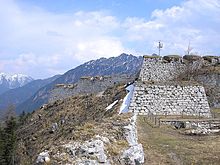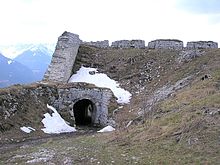Schlosskopf fortress
The Schlosskopf Fortress , formerly the Schlosskopf Fortress , is located about 1250 m above the Ehrenberg Castle and the Reutte market in Ausserfern in Tyrol . Castle and fortress together with the associated hermitage and Fort Claudia (Hochschanz) form one of the most important fortress ensembles in Central Europe.
history
The Schlossberg towers over the nearby Ehrenberg Castle by around 150 meters. The castle could be shot from the mountain plateau ready for a storm, which actually happened in 1703, when the Tyroleans recaptured the castle from the Bavarians by carting heavy artillery from Weißenbach for kilometers up the ridge and attacking their own castle.
As early as 1645, the sovereign builder Elias Gumpp planned a brick redoubt on the Hornberg. In addition, Gumpp demanded the fortification of the "Schlossanger" between the castle and Hornberg with a horn work . However, Gumpp's plans were not yet implemented at that time.
The strategic necessity of a fortress on the Hornberg became evident as early as 1703 when the Bavarians invaded ( War of the Spanish Succession ). After the fighting ended, a sentry box was built on the mountain, which was reinforced by palisades . In 1726 the expansion into a fortress began , which however had to be stopped again shortly afterwards. The fortress construction was continued in 1733 and finished in 1741 under the fortress commander Johann Andre von Pach . The construction costs are said to have amounted to more than three million guilders, which in view of the size of the fortress and the complicated construction site logistics seems quite realistic.
As early as 1782, however, the Tyrolean fortresses were abandoned, except for Kufstein, for military and financial reasons. The lock head never had to prove itself militarily.
The Austrian government then sold the Ehrenberg castle and fortress complex for 2,000 guilders to two citizens of the Reutte market. These cleared the facilities down to the foundation walls and removed everything that could be used. The remains of the huge ensemble fell into disrepair almost unhindered, and it was not until 1970 that serious efforts to preserve Ehrenberg Castle began.
The Schlosskopf was almost completely forgotten by the year 2000 and could only be reached on steep, sometimes dangerous mountain paths. In the course of the expansion of the Ostallgäu-Ausserfern castle region, however, those responsible recognized the high architectural and historical value of the entire complex. The fortress mountain was completely cleared and the first renovation measures began on the ailing fortress walls.
After the renovation, the fortress site was redesigned to become the "Schaufestung Schlosskopf" (opening: July 2008). The historical ensemble was supplemented by a few viewing platforms and towers in metal construction. A replica of a wooden pedal crane enables visitors to move even larger blocks of stone as part of a guided tour.
The expansion of the fortress is part of the planning concept for the "Burgenwelten Ehrenberg". The measures that have already been carried out and are still planned are not without controversy. In 2014 a suspension bridge was completed that connects Ehrenberg Castle and the small Fort Claudia on the other side of the main road.
description
The arrow-shaped ground plan of the fortress adapts to the terrain. The facility is almost 200 m long and between 40 and 70 m wide. The “Hohe Batterie” secures the system against the high plateau, which is preceded by a large Vorwerk . The main entrance leads as a tunnel through the left front of the tenaillierte (angled) rampart. In the front part of the gate tunnel, a "carousel" enabled two vehicles or guns to pass through at the same time. For this purpose, arched side tunnels were created next to the main corridor. Behind the Vorwerk, the "Hohe Batterie" is elevated on a rocky reef, the gateway is protected by two small bastions on the slopes of the Vorwerk.
The core plant is accessible through another long tunnel that runs under the "High Battery" - the main plant with its gun emplacements. A large part of the south-eastern front of the ramparts of the main fortress is missing today. The flanks of the core work at an angle, thus forming so-called "Saillants", which made it possible to brush the sides. The elongated ruins of the barracks in the north above the steep drop heralds the interior development .
At the same time as the fortress, the ruinous hornwork on the Schloßanger and the long connecting walls between the castle head and Ehrenberg Castle were built. Together with the castle, the hermitage and the Fort Claudia, the fortress forms one of the most important fortress ensembles in the Alpine region, which monitored and secured access to the Fernpass.
The entire fortress area was cleared after 2000; before that, orientation on the densely overgrown area was almost impossible. The renovation work on the Schlosskopf has ended for the time being with the opening of the show fortress.
Web links
literature
- Richard Lipp: Ehrenberg - history and stories (publications of the museum association of the Reutte district, volume II). Reutte, 2006. ISBN 3-9502282-0-9 , ISBN 978-3-9502282-0-5
- Oswald Trapp: Tiroler Burgenbuch, VII, Oberinntal and Ausserfern . Bozen, Innsbruck, Vienna, 1986, ISBN 88-7014-391-0
Coordinates: 47 ° 27 ′ 52 ″ N , 10 ° 42 ′ 40 ″ E





